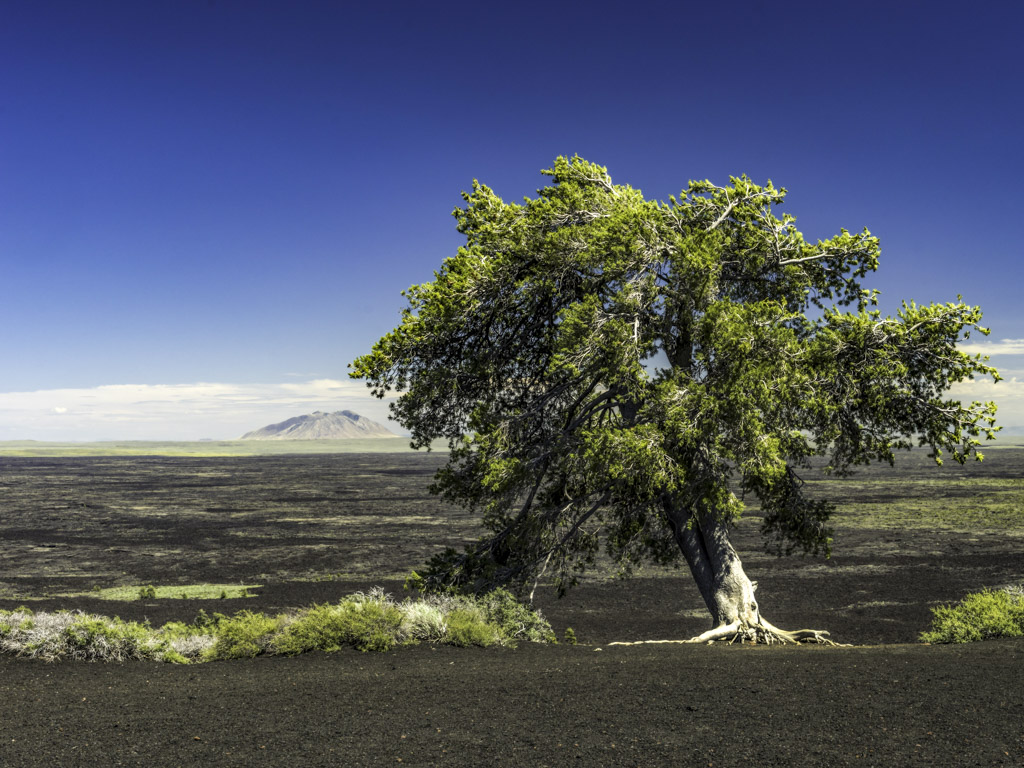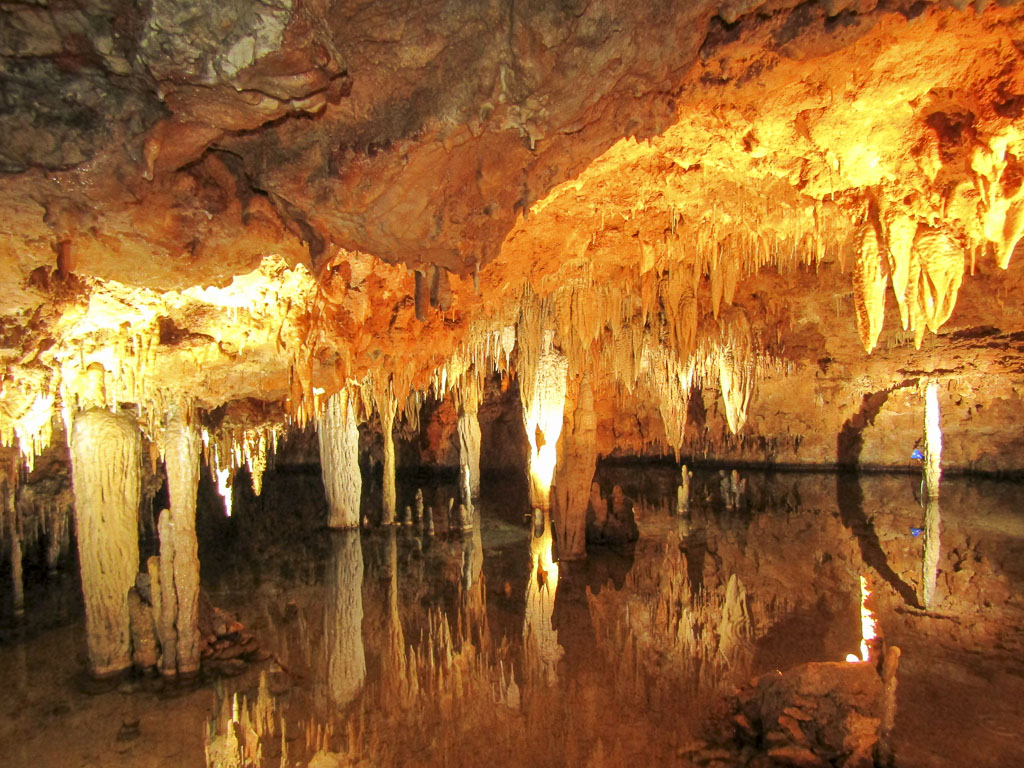Want to go to the moon? I can clue you in on a much cheaper–and much faster–method for getting there, than hitting up our friends at NASA. Craters of the Moon National Monument and Preserve in south-central Idaho, and visiting Craters of the Moon is the best way to get your out-of-this-world fix. So, I put together this Craters of the Moon Trip Planner to help you have that experienced. We’ll talk about camping at Craters of the Moon, Hiking at Craters of the Moon, and more.
Yet, it’s often overlooked by road trippers because it’s in the middle of nowhere and not technically a “national park”. When people hear “national preserve and monument”, they tend to think of a small scenic area for viewing; something to stop at for ten minutes before driving on.
But that’s not the case here; there is a variety of things to do at Craters of the Moon, including overnight camping, a winding scenic drive, and mysterious caves to explore. Most of all, there is uniquely beautiful hiking at Craters of the Moon.
You could easily spend a full weekend here–but be prepared to really feel like you’re on the moon, because there’s no cell phone coverage or restaurants nearby. But before we dive into all of its otherworldly beauty, and the full gamut of our Craters of the Moon trip planner, let’s give it a proper introduction.
What is Craters of the Moon National Monument and Preserve?



Craters of the Moon National Monument and Preserve consists of 410,000 acres of volcanic flood basalt land–basically, a beautiful wasteland of molten lava rock. Believe it or not, the same volcanic hot spot that is active in Yellowstone today once formed the Craters landscape.
And, like other familiar wasteland environments, such as Death Valley, there’s actually a lot of life in Craters, with over 400 square miles of thriving sagebrush grassland. The park also has some of the world’s best examples of lava tubes, tree molds, and even the world’s deepest rift crack, at 800 feet deep.
I personally had never considered visiting Craters of the Moon, but I ended up at its location. I first thought of it as many others do–a place I’ll grab a picture at since I happen to be passing through. But once I entered the park, I knew I needed to stay.
Since I live full-time out of my campervan (and work remotely), I have the flexibility to change my schedule as I go. I bought a campground spot for the night and watched the sun set over the barren landscape, until it became one of the darkest nights I’ve experienced.
Your Craters of the Moon Trip Planner
Getting to Craters of the Moon

On the National Parks Service website, Craters of the Moon does not have a physical address within a town or city–it’s full address is simply “1266 Craters Loop Road” in Idaho. The only entrance point is off US Highway 20/26/93, which is 18 miles southwest of the city of Arco, and 24 miles northeast of Carey, Idaho. Good news is, if you’re on that road, you’re not going to miss it!
The NPS website recommends only high-clearance vehicles with four-wheel drive, but I’m not sure why as all of the roads I drove on were paved and very well-maintained. My van is rear-wheel drive and had no issues, given it was summertime and I wasn’t dealing with icy roads or bad weather. While there are some steep winding roads that could be tricky in wintertime, overall, I’d say any vehicle would be perfectly fine here in all other seasons.
Where to Stay for a Weekend or Day Trip at Craters of the Moon

Overnight Options – Camping at Craters of the Moon
Craters of the Moon offers a variety of overnight options. You can stay at one of their first-come-first-serve spots at Lava Flow Campground for $15 a night, that includes enough room for two tents and cars, and a charcoal grill (no wood fires allowed).
They also have group camping that can accommodate groups of up to thirty people, for $30 a night–the area is tucked away behind grassy hills, unlike Lava Flow Campground where you’re in the heart of the desolate rock land. You have to reserve this at recreation.gov.

Lastly, if you’re really ambitious, you can acquire a backpacker’s permit and camp in the backcountry of Craters. Permits are free and can be obtained at the visitor’s center.
If you have your mind set on a hotel bed, you’ll have to drive the 18 miles to nearby Arco to get a room.
Things to Do at Craters of the Moon
No Craters of the Moon trip planner would be complete without sharing the scenic things to do, and giving you full details on some of the otherworldly hikes.
Driving Scenic Loop Drive

Right when you enter the park, Lava Flow Campground will be immediately on your right, and if you keep going, you’re now on the Scenic Loop Drive. Within the seven-mile drive, prepare to wind around, go up, or go through volcanic geologic formations. It’s a great way to get a well-balanced feel for the place–and be prepared to do a lot of stopping for sight-seeing or hiking!
Hiking at Craters of the Moon

Bring sunscreen, sunglasses, and a hat because this place has zero shade! I regretted not bringing a baseball cap on one of the hikes I did, after making the poor decision to go at high noon.
Here are some of the more popular trails that vary in length, depending on your hiking desires. Hiking at Craters of the Moon takes you through the surreal environment, and it is the main goal for many visiting Craters of the Moon.
Devil’s Orchard Trail

I walked this trail twice because it’s so short (0.5 miles) and so eerily beautiful! A paved, flat trail winds through a pretty barren landscape, with lots of twisted trees dispersed throughout, that look like they’re out of a scary movie. Educational signs throughout the trail provide insight on the unique landscape.
Inferno Cone Trail

In the short 0.4 miles of this trail, you go winding up a steep pitch to overlook the Great Rift, Pioneer Mountains, and Snake River Plain. It’s a great photo spot, with the lush lone tree of our cover photo growing on the rim of the cone. Extremely worth it, and a must when visiting Craters of the Moon, even if you have a fear of heights.
Broken Top Loop Trail

This 1.8 mile-long trail will give you views to just about every unique volcanic feature in the park. This one is almost my favorite hike because it’s just so unique; you’re literally climbing up a crater. It’s a little steep getting up near the top and the loose ground makes for slightly difficult footing, but nothing overly challenging. Also, it was VERY windy when I went!
Tree Molds Trail
I found this to be the most underwhelming hike because it was like walking through a desert of shrubs (baking in the sun, of course) with the promise of unique tree molds at the end of the 2-mile trail. But the tree molds were almost unnoticeable if they hadn’t been roped off. Overall, it’s still a unique (and easy, flat) hike, and worth your time–but maybe go at sunset instead of the afternoon!
Spatter Cones Trail

This 0.1 mile hike was my absolute favorite for hiking at Craters of the Moon! Approaching the spatter cone looks like you’re approaching a mini volcano on the moon. The hike itself is a straight, steep pitch up this gravel-based trail that plops you on the top of a big plain. It was insanely windy at the top–and there was even one of those spindly, scary movie trees at the top. The views were breathtaking and the otherworldliness was priceless.
North Crater Trail

A 3.5 mile-long trail that actually loops around–and then goes down into–a crater. It has access to one of the lava tube caves as well, but unfortunately both are currently closed due to COVID-19 restrictions and trail maintenance.
Wilderness Trail

Like its name suggests, you will be immersed in wilderness and solitude once going on this 8 mile-long hike in the backcountry. I did not do this hike, but it includes views of lava trees, cinder cones, and open backcountry. It also leads to Echo Crater, which is where the NPS recommends camping if you’re looking to do backcountry camping.
Cave Exploration

Unfortunately, I was not able to explore the famous caves due to Covid restrictions being in place at the time I was visiting Craters of the Moon. That being said, fingers crossed they have re-opened by the time you’re there! If so, make sure to obtain a permit at the Visitors Center before entering any of the caves, and bring along a flashlight. Here’s a brief description of the five caves:
Four of the five caves branch off of one main trail called Caves Trail, which is rated as moderate and 1.6 miles long. While the entrance to the main trail is paved, all of the caves are not paved and consist of uneven, jaggedy lava rock floors.
Dew Drop Cave and Beauty Cave are rated as moderate with boulder entrances, Indian Tunnel is rated as easy and only 800 feet long, and Boy Scout Cave is rated as difficult, partially due to its rocky entrance and tight quarters.
The fifth cave is called Buffalo Cave and–as mentioned earlier–is only accessible via the Broken Top Loop Trail. Due to its tightness and low ceilings, it’s rated as difficult. I wish I could provide more insight into the caves scene at Craters of the Moon, but I have no doubt they are all worth checking out.
Winter Time Activities

Visiting Craters of the Moon may not sound possible during the wintertime, and the Scenic Loop Drive is closed to vehicles. However it is accessible for anyone interested in walking, skiing, or biking it. What’s more, the park is open to anyone interested in skiing or snowshoeing the main trails or backcountry area.

Orange snow poles are used as markers along trails, where the scenery is said to be an intense contrast of bright white snow to black volcanic rock. That sounds like…I’m going to have to do a second visit come wintertime!
Isn’t it Time to Put Visiting Craters of the Moon on Your List?

Craters of the Moon National Monument and Preserve sits in middle-of-nowhere, Idaho, and remains quite a hidden gem. You will love the surreal landscape and feel otherworldly when hiking at Craters of the Moon, and, you will never have to worry about a big crowd! Hopefully, this Craters of the Moon trip planner has shown all it has to offer and has inspired you to plan your own weekend getaway!
Be sure to Pin It for later!


About the Author

Hilary Bird is a digital nomad that left the corporate world to try van life almost a year ago. She’s been on the road full-time in her self-converted Holiday Inn shuttle bus for four months at the time this was written, and is documenting her adventures through blogging and Instagram, at @greenvango!






One thought on “A Craters of the Moon Trip Planner”